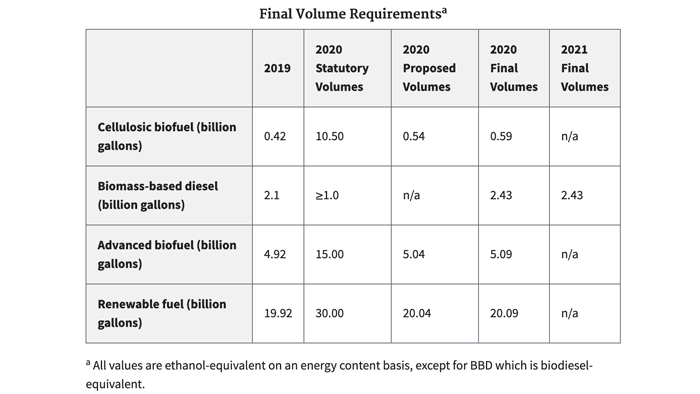
U.S. EPA finalizes 2020 biofuel rule
The U.S. Environmental Protection Agency (EPA) finalized a rule that establishes the required renewable volumes under the Renewable Fuel Standard (RFS) program for 2020, and the biomass-based diesel volume for 2021, leaving a key part of the rule unchanged from an earlier proposal that the corn lobby had criticized.
Under the RFS, the EPA is responsible for establishing biofuel blending requirements for the refining industry to help farmers by boosting demand for corn- and soybean-based fuels, while reducing U.S. dependence on oil.
The final rule increases the volume for blending requirements to 20.09 billion gallons in 2020, up from 19.92 billion gallons in 2019. The mandate included 15 billion gallons of conventional biofuels like ethanol, unchanged from 2019.
The key elements of the final rule are as follows:
- “Conventional” biofuel volumes, primarily met by corn ethanol, will be maintained at the 15 billion gallon target set by Congress for 2020.
- Cellulosic biofuel volumes for 2020, and thus advanced biofuel volumes, will increase by almost 170 million gallons over the 2019 standard. Biomass-based diesel volumes for 2021 will be equivalent to the standard for 2020, still more than double the statutory requirement. EPA will closely examine the labeling requirements for E15 fuel and move forward with clarifying regulations as needed.
- EPA has modified the way RFS obligations are determined to better ensure that these volumes are met, while still allowing for relief for small refineries consistent with the direction provided by Congress under the statute.
The point of contention involves a plan the EPA introduced in the rule to compensate the biofuel industry for the agency’s expanded use of exemptions from requirements given to oil refiners. The Trump administration has roughly quadrupled the number of so-called Small Refinery Exemptions (SREs), to help refiners in financial distress, which corn farmers and biofuel producers claim has undercut demand for fuel ethanol.
First unveiled by the EPA in October, the plan raises the biofuel volumes that some refineries must blend in 2020 based on U.S. Department of Energy (DOE) recommendations for volumes that should be exempted. The rule finalizes the methodology based on the 2016–2018 annual average of DOE recommendations.
The biofuel industry wanted the adjustments to be based on actual volumes waived, since the EPA routinely waives higher volumes than the DOE recommends.
The EPA said the methodology would work, provided DOE recommendations are followed in the future. The EPA said it is committed to following the DOE recommendations.
“We plan on demonstrating our commitment to that as soon as the 2019 SREs, which we anticipate granting relatively early on once they’re all received in 2020,” a senior EPA official said.
Through this rule, the EPA has modified the RFS program by projecting small refinery relief to ensure that these final volumes are met, while adjudicating small refinery relief when appropriate, the agency claims.
“As proposed, we are finalizing a projection methodology based on the 2016-2018 annual average of exempted volumes had EPA strictly followed the Department of Energy (DOE) recommendations of 770 million Renewable Identification Numbers (RINs) in those years, including granting 50% relief where DOE recommended 50% relief. This is our general approach to adjudicating Small Refinery Exemption (SRE) petitions going forward, beginning with 2019 SRE petitions and including 2020 SRE petitions and beyond, we are committed to following the DOE recommendations. By proposing effectively 15.8 billion gallons for 2020 we will ensure meeting our target of 15 billion gallons,’” the EPA said in a statement.













